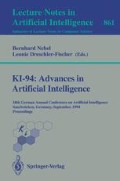Abstract
We describe an approach whereby specificity notions are introduced into circumscriptive theories. In this approach, a default theory is initially given as a set of strict and defeasible conditionals. By making use of a theory of default conditionals, here given by System Z, we isolate minimal sets of defaults with specificity conflicts. From the specificity information intrinsic in these sets, a propositional theory is specified. By circumscribing a set of “abnormality” propositions, one obtains a nonmonotonic reasoning system in which specificity information is appropriately handled. This notion of specificity subsumes that of property inheritance, and so in this approach a bird will fly (by default) whereas a penguin will not. This work differs from previous work in specifying priorities in circumscription, in that priorities are obtained from information intrinsic in a set of conditionals, rather than assumed to exist a priori. This paper extends earlier work in hybrid nonmonotonic reasoning systems: First, in this previous work specificity issues were addressed with respect to Default Logic. Second, we here augment the approach to allow strict as well as default knowledge.
Preview
Unable to display preview. Download preview PDF.
References
F. Baader and B. Hollunder. How to prefer more specific defaults in terminological default logic. In Proc. IJCAI-93, pages 669–674, Chambéry, Fr., 1993.
Craig Boutilier. Conditional Logics for Default Reasoning and Belief Revision. PhD thesis, Department of Computer Science, University of Toronto, 1992.
Craig Boutilier. What is a default priority? In Canadian Conference on AI, Vancouver, B.C., 1992.
G. Brewka. Adding priorities and specificity to default logic. Manuscript, 1993.
J. P. Delgrande and T. Schaub. A general approach to specificity in default reasoning. In Fourth International Conference on Principles of Knowledge Representation and Reasoning, Bonn, Germany, May 1994.
J.P. Delgrande. A first-order conditional logic for prototypical properties. Artificial Intelligence, 33(1):105–130, 1987.
Hector Geffner and Judea Pearl. Conditional entailment: Bridging two approaches to default reasoning. Artificial Intelligence, 53(2–3):209–244, 1992.
M. Ginsberg. A circumscriprive theorem prover. Artificial Intelligence, 39:209–230, 1989.
Moisés Goldszmidt. Qualitative Probabilities: A Normative Framework for Commonsense Reasoning. PhD thesis, Department of Computer Science, University of California, Los Angeles, 1992.
B. Grosof. Generalizing prioritization. In J. A. Allen, R. Fikes, and E. Sandewall, editors, Proceedings of the Second International Conference on the Principles of Knowledge Representation and Reasoning, pages 289–300, San Mateo, CA, April 1991. Morgan Kaufmann.
S. Kraus, D. Lehmann, and M. Magidor. Nonmonotonic reasoning, preferential models and cumulative logics. Artificial Intelligence, 44(1–2), 1990.
V. Lifschitz. Computing circumscription. In Proc. IJCAI-85, pages 121–127, Los Angeles, 1985.
J. McCarthy. Circumscription — a form of non-monotonic reasoning. Artificial Intelligence, 13:27–39, 1980.
J. McCarthy. Applications of circumscription to formalizing common-sense knowledge. Artificial Intelligence, 28:89–116, 1986.
J. Pearl. Probabilistic semantics for nonmonotonic reasoning: A survey. In Proc. KR-89, pages 505–516, Toronto, May 1989. Morgan Kaufman.
J. Pearl. System Z: A natural ordering of defaults with tractable applications to nonmonotonic reasoning. In Proc. of the Third Conference on Theoretical Aspects of Reasoning About Knowledge, pages 121–135, Pacific Grove, Ca., 1990.
D. Poole. On the comparison of theories: Preferring the most specific explanation. In Proc. IJCAI-85, pages 144–147, 1985.
R. Reiter. A logic for default reasoning. Artificial Intelligence, 13:81–132, 1980.
Author information
Authors and Affiliations
Editor information
Rights and permissions
Copyright information
© 1994 Springer-Verlag Berlin Heidelberg
About this paper
Cite this paper
Delgrande, J.P., Schaub, T.H. (1994). Incorporating specificity into circumscriptive theories. In: Nebel, B., Dreschler-Fischer, L. (eds) KI-94: Advances in Artificial Intelligence. KI 1994. Lecture Notes in Computer Science, vol 861. Springer, Berlin, Heidelberg. https://doi.org/10.1007/3-540-58467-6_24
Download citation
DOI: https://doi.org/10.1007/3-540-58467-6_24
Published:
Publisher Name: Springer, Berlin, Heidelberg
Print ISBN: 978-3-540-58467-4
Online ISBN: 978-3-540-48979-5
eBook Packages: Springer Book Archive

